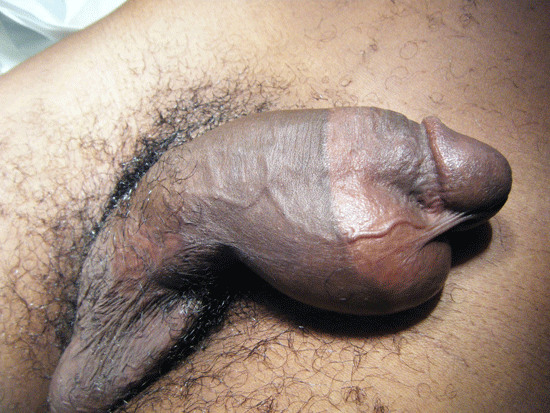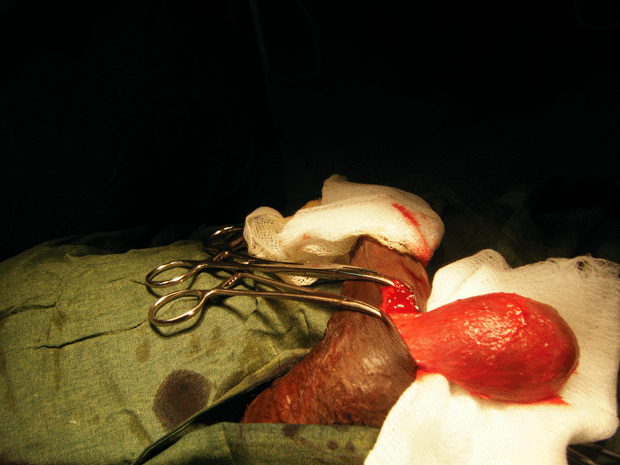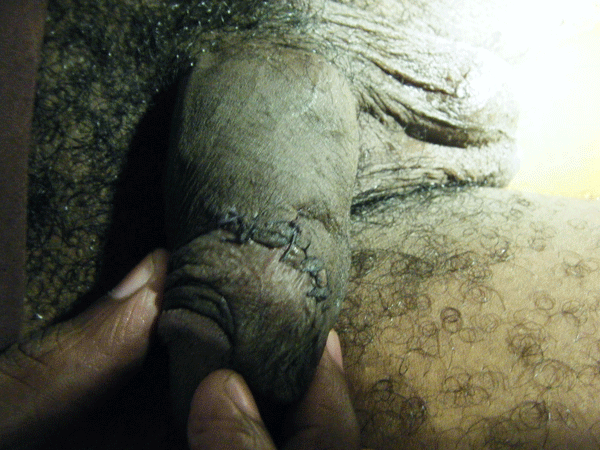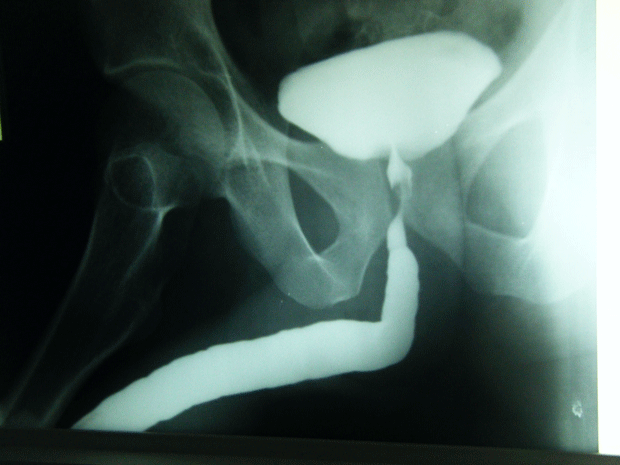Epidermoid cyst of the penis
A case of a 25 year-old man with an epidermoid cyst of the penis is reported.
Authors:
Corresponding Author: TFEIL YAHYA MD (FWACS) Urologist Surgeon, Department of urology Faculty of Medicine- Nouakchott University. E-mail: tefeil2000@gmail.com
He had no history of trauma, inflammation, urinary tract infection, hematuria or dysuria. The elastic mass was non tender, freely movable within the dermis, and had a smooth surface (Fig.2).
Figure 2.
There was neither a keratin-filled punctum nor any signs of inflammation. Excision of the cyst was performed under loco-regional anaesthesia through a semi-circular incision (Fig.3).
Figure 3.
Macroscopically, the cut surface of the mass appeared to be full of a cheesy material, and both cytology and culture results were negative. Histological examination revealed that the wall of the cyst was lined with stratified squamous epithelium and laminated keratin. It did not contain either skin appendages or germ cells. The final diagnosis was epidermoid cyst of the penis. No recurrence has been noted in the year since excision.
Discussion
Epidermal cysts are common benign tumors that may arise from the infundibular portion of the hair follicle spontaneously or subsequent to trauma, but penile epidermoid cysts are uncommon and usually congenital. The etiology is not clear. Some authors have adduced that it may develop from median raphe cyst, following an abnormal closure of the median raphe during embryogenesis [3]. Others have suggested that median raphe cysts are a different entity from epidermoid cysts [4]. These cysts may occur because of occluded hair follicles, the mechanical implantation such as that involving injection of epidermal fragments, and obstructed eccrine ducts [2]. The present case is more likely to have not originated from a median raphe cyst because of the patient’s age and the development of the cyst in a short period of time. Penile epidermoid cyst can be diagnosed by a careful examination with evaluation by ultrasonography and/or computerized tomography. Dermoid cyst, teratoma, and urethral diverticula should be considered in the differential diagnosis of the epidermoid cyst [2]. An epidermal cyst is lined by well-developed stratified epithelium, and often contains keratin, which can be expressed from the cyst, while a dermoid cyst contains skin and skin appendages, and a teratoma contains derivatives from other germ cells. Therefore, these lesions can be distinguished from an epidermoid cyst. Unlike the urethral diverticula, such cysts do not have a connection with the urethra (Fig.4).
Figure 4.
Although epidermoid cysts are benign lesions, neoplastic transformation of their epithelium has been reported to occur rarely [5, 6]. No cases of malignancy arising in the wall of an epidermoid cyst of penis have been reported previously [1, 3]. The best treatment of penile epidermoid cysts is total excision. One year after complete removal of the cyst, we did not note any local recurrence. There were no findings of malignancy in our case, similar to that reported by others [1, 3]. Although malignant transformation is very rare, it should be kept in mind and following excision of an epidermoid cyst, patients should undergo long term follow up.
Conclusion
In conclusion, epidermoid cyst of penis is rare, in the pediatric age group it can occur after a seemingly minor surgical procedure such as circumcision. The swelling may remain largely asymptomatic unless secondarily infected. Care needs to be taken while performing even minor surgical procedures to avoid this complication. The condition should to be treated by complete excision. The rare possibility of malignant transformation must be borne in mind.
References:
1-Suwa M, Takeda M, Bilim V, Takahashi K. Epidermoid cyst of the penis: A case report and review of the literature. Int J Urol 2000; 7: 431—433.
2- Khana S. Epidermoid cyst of the glans penis. Eur Urol 1991; 19: 176–177.
3-Rattan J, Rattan S, Gupta DK. Epidermoid cyst of the penis with extension into the pelvis. J Urol 1997; 158: 593–594.
4-Little Jr JS, Keating MA, Rink RC. Median raphe cyst of the genitalia. J Urol 1992; 148: 1872–1873.
5- Dini M, Innocenti A, Romano GF. Basal cell carcinoma arising from epidermoid cyst: A case report. Dermatol Surg 2001; 27: 585–586.
6- Lopez-Rios F, Rodriguez-Peralto JL, Castano E, Benito A. Squamous cell carcinoma arising in a cutaneous epidermal cyst: Case report and literature review. Am J Dermatopathol 1999; 21: 174–177.
Date added to bjui.org: 05/08/2012
DOI: 10.1002/BJUIw-2011-140-web




